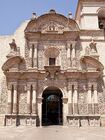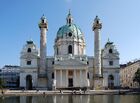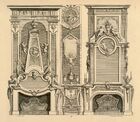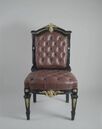Baroque is a term used to describe the predominant art movement and style of European architecture, music, and art of the 17th and early 18th centuries.
The term "Baroque" originated from the Portuguese word barroco, which means "misshapen pearl." Barroco was used first to criticize the overly ornate music of the Baroque era. It was later also applied to art, fashion, and architecture of the period, but eventually lost its pejorative tone.
Though relatively minor, the 20th and 21st centuries have seen a renewed and prolonged interest in Baroque music, art, and motifs. Famously, Dolce and Gabbana's 2012 collection of Baroque-inspired clothing confirmed a subtle, decades-long trend: a comeback for some of the Baroque era's most recognizable patterns and colors.
Visual[]
The Baroque artistic movement is characterized by its melodramatic tableaus, lavish ornamentation, use of deep colors, chiaroscuro, and asymmetry. The paintings most commonly depict scenes from the Bible or Greek mythology and portraits of nobility.
Common visuals include:
- Landscapes
- Flowers
- Religious figures (saints, angels, demons, etc.)
- Mythical creatures
- Ancient Greek and Roman characters
- Celestial bodies (planets, constellations, sun/moon, etc.)
- Painted ceilings
- Candles
- Musical instruments
- Memento mori
- Masquerade balls
- Fountains
- Castles
- Large, grand churches
- Ornate palaces
- Opera houses
- Pastoral scenes (flower baskets, shepherds, lovers in the woods, etc.)
- Banquets
Architecture[]
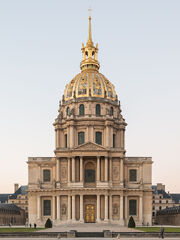
The Dôme des Invalides, Paris, by Jules Hardouin-Mansart, 1677–1706, an example of religious Baroque architecture
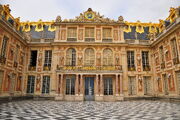
The Marble Court of the Palace of Versailles, Versailles, France, 1680, an example of secular Baroque architecture
The Baroque emerged from the Counter Reformation as an attempt by the Catholic Church in Rome to convey its power and to emphasize the magnificence of God. The Baroque and its late variant the Rococo were the first truly global styles in the arts. Dominating more than two centuries of art and architecture in Europe, Latin America and beyond from circa 1580 to circa 1800. Born in the painting studios of Bologna and Rome in the 1580s and 1590s, and in Roman sculptural and architectural ateliers in the second and third decades of the 17th century, the Baroque spread swiftly throughout Italy, Spain and Portugal, Flanders, France, the Netherlands, England, Scandinavia, and Russia, as well as to central and eastern European centres from Munich (Germany) to Vilnius (Lithuania). The Portuguese, Spanish and French empires and the Dutch treading network had a leading role in spreading the two styles into the Americas and colonial Africa and Asia, to places such as Lima, Mozambique, Goa and the Philippines. Due to its spread in regions with different architectural traditions, multiple kinds of Baroque appeared based on location, different in some aspects, but similar overall. For example, French Baroque appeared severe and detached by comparison, preempting Neoclassicism and the architecture of the Age of Enlightenment. Hybrid Native American/European Baroque architecture first appeared in South America (as opposed to Mexico) in the late 17th century, after the indigenous symbols and styles that characterize this unusual variant of Baroque had been kept alive over the preceding century in other media, a very good example of this being the Jesuir Church in Arequipa (Peru).
The first Baroque buildings were cathedrals, churches and monasteries, soon joined by civic buildings, mansions, and palaces. Being characterized by dynamism, for the first time walls, façades and interiors curved, a good example being San Carlo alle Quattro Fontane in Rome. Baroque architects took the basic elements of Renaissance architecture, including domes and colonnades, and made them higher, grander, more decorated, and more dramatic. The interior effects were often achieved with the use of quadratura, or trompe-l'œil painting combined with sculpture: the eye is drawn upward, giving the illusion that one is looking into the heavens. Clusters of sculpted angels and painted figures crowd the ceiling. Light was also used for dramatic effect; it streamed down from cupolas and was reflected from an abundance of gilding. Solomonic columns were often used, to give an illusion of upwards motion and other decorative elements occupied every available space. In Baroque palaces, grand stairways became a central element. Besides architecture, Baroque painting and sculpture are characterized by dynamism too. This is in contrast with how static and peaceful Renaissance art is.
Besides the building itself, the space where it was placed had a role too. Both Baroque and Rococo buildings try to seize viewers' attention and to dominate their surroundings, whether on a small scale such as the San Carlo alle Quattro Fontane in Rome, or on a massive one, like the new facade of the Santiago de Compostela Cathedral, designed to tower over the city. A manifestation of power and authority on the grandest scale, Baroque urban planning and renewal was promoted by the church and the state alike. It was the first era since antiquity to experience mass migration into cities, and urban planners took idealistic measures to regulate them. The most notable early example was Domenico Fontana's restructuring of Rome's street plan of Pope Sixtus V. Architects had experimented with idealized city schemes since the early Renaissance, examples being Leon Battista Alberti (1404-1472) planning a centralized model city, with streets leading to a central piazza, or Filarete (Antonio di Pietro Aver(u)lino, c. 1400-c. 1469) designing a round city named Sforzinda (1451-1456) that he based on parts of the human body in the idea that a healthy city should reflect the physiognomy of its inhabitants. However, none of these idealistic cities has ever been built. In fact, few such projects were put into practice in Europe as new cities were prohibitively costly and existing urban areas, with existing churches and palaces, could not be demolished. Only in the Americas, where architects often had a clean space to work with, were such cities possible, as in Lima (Peru) or Buenos Aires (Argentina). The earliest Baroque ideal city is Zamość, built north-east of Krakow (Poland) by the Italian architect Bernardo Morando (c. 1540-1600), being a centralized town focusing on a square with radiating streets. Where entire cities could not be rebuilt, patrons and architects compensated by creating spacious and symmetrical squares, often with avenues and radiating out at perpendicular angles and focusing on a fountain, statue or obelisk. A good example of this is the Place des Vosges (formerly Place Royale), commissioned by Henry IV probably after plans by Baptiste du Cerceau (1545-1590). The most famous Baroque space in the world is Gianlorenzo Bernini's St. Peter's Square in Rome. Similar with ideal urban planning, Baroque gardens are characterized by straight and readapting avenues, with geometric spaces.
Art[]
Succeeding Mannerism, and developing as a result of religious tensions across Europe, Baroque art emerged in the late 16th century. The name may derive from 'barocco', the Portugueseword for misshaped pearl, and it describes art that combined emotion, dynamism and dramawith powerful color, realism and strong tonal contrasts. Between 1545 and 1563 at the Council of Trent, it was decided that religious art must encourage piety, realism and accuracy, and, by attracting viewers' attention and empathy, glorify the Catholic Church and strengthen the image of Catholicism. In the next century the radical new styles of Baroque art both embraced and developed High Renaissance models, and broke new ground both in religious art and in new varieties of secular art – above all landscape.
A key feature of multiple Baroque paintings is the strong contrasts of light and darkness on certain parts of the picture to direct attention to the central actions or figures. This was done for producing a dramatic atmosphere and creating spectacular effects of highlight and shadow. Artists wanted to make the viewer experience awe. They also often used asymmetry, with action occurring away from the centre of the picture, and created axes that were neither vertical nor horizontal, but slanting to the left or right, giving a sense of instability and movement.
Design[]

Baroque furniture detail in the Rijksmuseum in Amsterdam, the Netherlands. Notice how despite being highly decorated, it is symmetrical and devided into rectangular sections
Applied arts prospered in this style. Baroque furniture could be as bombastic and covered in gold leaf, as the rooms they were meant to adorn, and their motifs and techniques were carefully calibrated to coordinate with the architect's overall decorative programme.
One of the most prestigious furniture makers was André Charles Boulle, known for his marquetry technique, made by gluing sheets of tortoiseshell and brass together and cut to form the design. His works were also adorned with gilded bronze mounts. Complex Gobelins tapestries featured scenes inspired by classical antiquity, and the Savonnerie manufactory produced big highly detailed carpets for the Louvre. These carpets with black or yellow backgrounds had a central motif or a medallion. Chinese porcelain, Delftware and mirrors fabricated at Saint-Gobain (France) spread rapidly in all princely palaces and aristocratic residences in France. During the reign of Louis XIV, big mirrors are put above fireplace mantels, and this trend will last long after the Baroque period, being popular even today when someone wants to have a Vintage room decor.
Despite being highly decorated, Baroque designs are characterized by rigor, symmetry and overall balance. Symmetrical elemnts flank vertical or horizontal axes. A key motif are human faces (aka mascarons), sometimes surrounded by radiating solar rays or by peacock tail-shaped ornaments called palmettes. Other motifs widely used in Baroque design include cherubs (aka putti), scallop shells, foliage spirals (aka rinceaux), lion heads, ram heads, gryphons, garlands of various leafs, flowers or fruits (aka festoons), acanthus leafs, urns, balusters (especially at the top of highly detailed cabinets), corbels, trophies of arms, modillions (often featuring inside a man from profile), oval-shaped frames called cartouches, tassels, ribbons, bows and rectagular or diaper (lozenge) lattice patterns decorated with dots or florets. Most of these ornaments will be also used in Rococo, Neoclassical and Victorian designs, but a little modified.
When it comes to furniture, large solid wood pieces were made of chestnut, walnut, or oak. They were often gilded, or decorated with veneer or marquetry made of many woods of various and contrasting tones. Gilded bronze fittings were added to the wood structure. Besides ornaments, bronze was also used for handles, lock plates, hinges and for other practical elements. Beds often had baldaquins with curatins, and were decorated with urns at the corners of their top. Tables, particularly consoles, were highly decorated. They had marble, porphyry or alabaster tops, and sometimes marquetry was used to create patterns. When it comes to seating, armchairs, chairs and folding stools were used.
Fashion[]
- Statement jewelry with large gemstones
- Crowns
- Long, trailing dresses
- Ballroom gowns
- Lace
- Ribbons
- Flowing capes
- Ornate/patterned coats and blazers
- Gold filigree jewelry
- Tassels
- Brocade trimming
- Pointed toe heels
Patterns, fabrics and materials:
- Jacquard
- Damask
- Checkered
- Toile de Jouy
- Chinoiserie
- Fleur de lis
- Marble
- Porcelain
- Silk
- Velvet
- Satin
Music[]
Baroque music is spirited and extravagant, much like its artistic and architectural counterparts. It is characterized by winding, florid melodies, and the bass line often serves as a "heartbeat" which drives the music forward.
Well known Baroque composers and some examples of their work:
- Johann Sebastian Bach
- Antonio Vivaldi
- Jean-Baptiste Lully
- George Frederic Handel
- Arcangelo Corelli
- Henry Purcell
LGBT Influence and Contributions[]
For LGBT people of the Baroque era, please see the Wikipedia articles for LGBT people in the 17th and 18th centuries.
In recent decades, some LGBT people have adopted the Baroque aesthetic as part of their stage or performing act. The trailblazing singer Klaus Nomi used Baroque music, motifs, and costumes in his performances in the 1970s and especially the 1980s. Presently, the singer Prince Poppycock dons stylized Baroque costumes for performances. The popular dancer Carlos Fittante specializes in Baroque-era dance, and often performs in full costume; this dancing provided healing after his partner died in the September 11, 2001 terrorist attacks in New York City.
Revivals and later influence[]
Similarly with other styles, like the Gothic or the Rococo, there was a revival of the Baroque during the 19th century. Neo-Baroque buildings, furniture, paintings, tableware, mantel clocks and other objects were created during the 19th and the early 20th centuries.
After WW1, styles of the past were seen as "dated" or "passé", including the Baroque. The complex ornaments of these movements were replaced by geometric shapes and abstracted motifs, or just simple blank surfaces, in Art Deco, Bauhaus and mid-century design. Later, during the late 2000s, the 2010s and the 2020, due to the interest for vintage stuff and the appreciation of young generation for styles of the past, new Baroque-inspired objects were and are produced.















